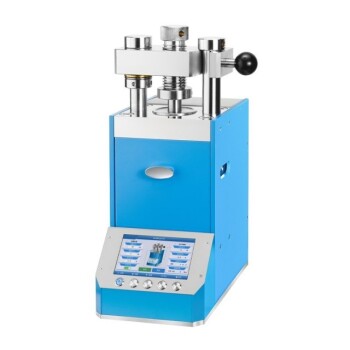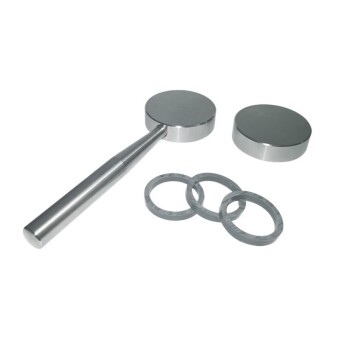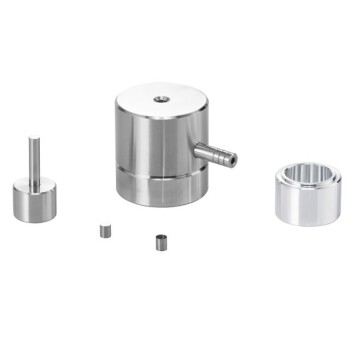In both laboratories and workshops, hydraulic pellet presses are fundamental tools used to transform loose powders into solid, dense samples. In educational settings, they provide tangible, hands-on lessons in material science and sample preparation. In industrial labs, they are indispensable engines for quality control, advanced research, and the development of new materials.
The true value of a hydraulic pellet press isn't just its ability to crush powder; it's about creating uniform, consistent, and analyzable samples from a wide range of raw materials. This act of standardization is the bedrock of both reliable scientific analysis and dependable industrial quality.
The Foundation: From Powder to Precise Pellet
A hydraulic press creates a consistent sample where one did not exist before, making messy powders manageable and measurable. This transformation is central to its value.
What a Hydraulic Press Actually Does
At its core, a hydraulic press applies a significant, controlled force to a material confined within a die set. This immense pressure forces the individual particles of a powder closer together, reducing the space between them and forming a solid, dense pellet.
Think of it like packing wet sand into a bucket to build a sandcastle. The press is your hands, the die is the bucket, and the resulting dense shape is the pellet, which is far more stable and uniform than the loose sand you started with.
The Principle of Repeatability
For scientific analysis or quality control, consistency is non-negotiable. A hydraulic press ensures that every pellet can be made under the exact same pressure conditions.
This repeatability eliminates variables, ensuring that any differences observed between two samples are due to the material itself, not the way the sample was prepared.
Core Applications in R&D and Quality Control
In industrial and research settings, the pellet press is a gateway to obtaining critical data. It prepares materials to be tested, analyzed, and perfected.
Sample Preparation for Spectroscopic Analysis
Many analytical techniques require a solid, uniform sample. The press is the tool that creates them.
For FTIR spectroscopy, a material is often mixed with potassium bromide (KBr) powder and pressed into a thin, transparent pellet. This allows infrared light to pass through for analysis.
For X-Ray Fluorescence (XRF), a press compacts loose powder into a flat, dense pellet with a smooth surface, ensuring the X-ray beam interacts with the sample uniformly for accurate elemental analysis.
Testing Material Strength and Durability
Hydraulic presses are used to directly test the compressive strength of a material. This is crucial for quality control in industries producing ceramics, pharmaceuticals, and other compacted products.
By applying force until the sample fractures, engineers can determine its physical limits and ensure it meets required performance standards.
Advanced Materials Development
Researchers rely on presses to create and test novel materials. This includes forming pellets for next-generation catalysts, developing new formulations for battery materials, and shaping high-performance ceramics.
The ability to precisely control pressure allows researchers to investigate how compaction affects a material's chemical and physical properties.
The Role in Educational Settings
In a university or technical college, a hydraulic press bridges the gap between theoretical knowledge and practical application.
Teaching Fundamental Material Science
A simple manual press provides a powerful demonstration of concepts like pressure, force, and density. Students can physically feel the resistance of a material as it compacts, turning an abstract formula into a tangible experience.
Training for Standard Laboratory Procedures
Using a press to prepare a KBr pellet for an FTIR spectrometer is a standard procedure in thousands of labs worldwide. Teaching students this technique prepares them for future roles in industry and academia.
Understanding the Trade-offs and Considerations
While incredibly useful, a hydraulic press is a powerful piece of equipment that requires proper understanding to be used effectively and safely.
Manual vs. Automatic Presses
Manual presses are excellent for educational settings and low-volume labs, as they are simpler and provide a direct feel for the compaction process.
Automatic presses offer superior repeatability and higher throughput, making them essential for quality control environments where dozens of identical samples must be prepared daily.
The Importance of the Die Set
The press provides the force, but the die set (the mold) determines the shape, diameter, and quality of the final pellet. A high-quality, polished die is critical for producing smooth pellets that eject easily and do not fracture.
Safety and Maintenance
Hydraulic systems operate under extremely high pressures. Users must be trained on proper operational procedures, including the use of safety shields, to prevent injury. Regular maintenance is also required to ensure the system remains safe and accurate.
Making the Right Choice for Your Application
Your specific goal will determine which features of a hydraulic press are most critical.
- If your primary focus is education: Prioritize a straightforward manual press with clear pressure gauges and robust safety features to best demonstrate scientific principles.
- If your primary focus is high-throughput quality control: An automated press with programmable pressure cycles is essential for ensuring consistency and maximizing operator efficiency.
- If your primary focus is advanced materials research: Seek a press with a high tonnage capacity and options like heated platens to investigate material behavior under diverse conditions.
Ultimately, selecting the right press is about empowering your team to convert raw materials into reliable data and innovative products.
Summary Table:
| Setting | Primary Use | Key Benefits |
|---|---|---|
| Educational | Hands-on learning, sample prep | Teaches material science, standard lab procedures |
| Industrial | Quality control, R&D | Ensures repeatability, enables precise analysis |
Ready to enhance your lab's capabilities with a reliable hydraulic pellet press? KINTEK specializes in lab press machines, including automatic lab presses, isostatic presses, and heated lab presses, designed to meet the needs of laboratories in education and industry. Our equipment ensures uniform sample preparation, improves accuracy in spectroscopic analysis, and boosts productivity in quality control. Contact us today to discuss how our solutions can empower your team to achieve better results!
Visual Guide

Related Products
- Laboratory Hydraulic Press 2T Lab Pellet Press for KBR FTIR
- Automatic Laboratory Hydraulic Press Lab Pellet Press Machine
- Laboratory Hydraulic Press Lab Pellet Press Machine for Glove Box
- Manual Laboratory Hydraulic Press Lab Pellet Press
- Laboratory Hydraulic Press Lab Pellet Press Button Battery Press
People Also Ask
- How is a hydraulic press used in sample preparation for spectroscopy? Achieve Accurate and Homogeneous Sample Pellets
- How are hydraulic presses used in spectroscopy and compositional determination? Enhance Accuracy in FTIR and XRF Analysis
- What is the purpose of making KBr pellets in the lab? Achieve High-Sensitivity FTIR Analysis for Accurate Results
- What are the benefits of reduced physical effort and space requirements in hydraulic mini presses? Boost Lab Efficiency and Flexibility
- What are the main advantages of using hydraulic presses for sample preparation? Achieve Precise, Uniform Samples for Reliable Analysis



















